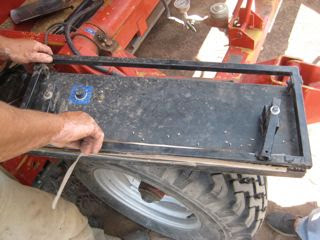Each bag will hold about 200 metric tons of grain. Typically, grain is stored for several months, but in some cases, wheat has been stored for a year.
Filling one bag takes about 1.5 to 2 hours, depending on the rate at which grain is brought to the bags. See the very short video on filling a grain bag. As the bag loader feeds grain into the bag, the grain pushes the loader forward. A brake is applied to the loader to provide some resistance. Using the proper brake pressure is critical to proper filling of the bag. If the brake is too soft, the bag will not be filled completely. If it is too hard, the bag will be stretched too tight and may not last as long. Loaders that have disk brakes with a single control are the best types to use. Some loaders apply a break to the tires and they require separate adjustments to both tires, making proper loading of the bags more difficult.
I met a person who is manufacturing a simple sealer for the bags. The sealer is called La Pipiola. You can watch the video on how the sealer works. They have a second, shorter video that shows some of the loading process as well. They seal the end of the bag and then fold the bag over on the sealed portion. As the first bit of grain loads into the bag, it loads on the sealed portion, helping to keep the seal strong. On the other end, there is no pressure from grain on the bag, making it easy to seal.
This system seems to work well in Argentina where winters are much warmer than in Kentucky or the Midwest. However, winters here are also drier. The wetter winters back home could make storage of grain in these bags more of a challenge. There is certainly some merit to testing this in the States. And, if you're looking for a good sealer, I know a guy!!






















